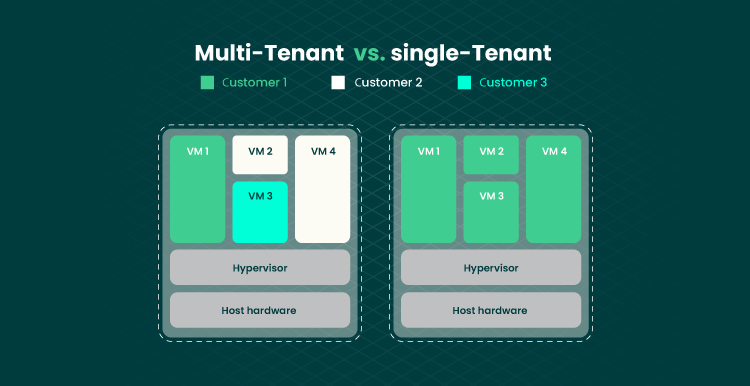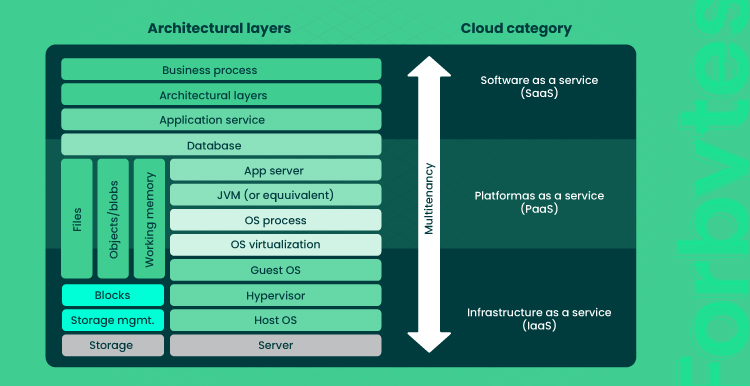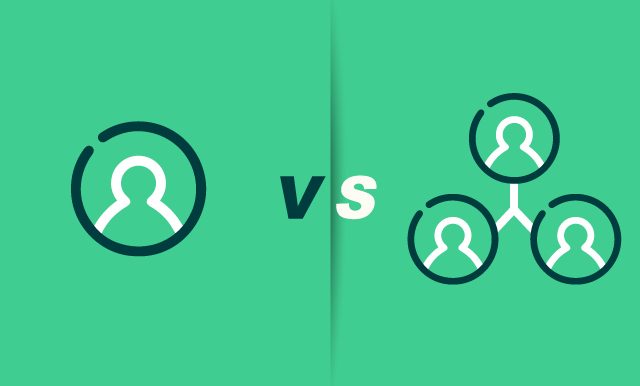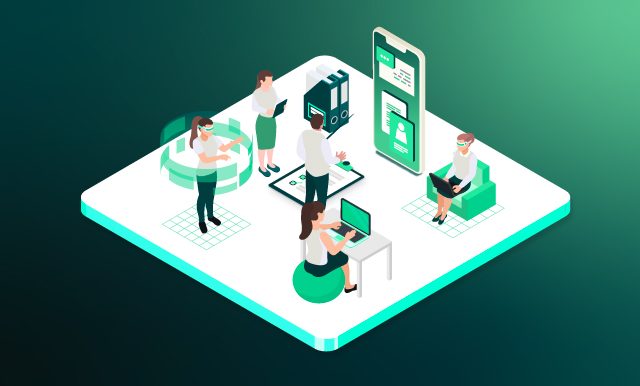SaaS-based cloud systems offer vast possibilities – from faster, more efficient resource allocation and price flexibility to continuous deployment that helps organizations stay competitive.
A lot of businesses are moving their infrastructure to the cloud, but this decision requires careful thought to determine the best approach for their business. There are two major approaches.
- The first is a SaaS cloud application that can be hosted on one physical machine for a single customer and is called single-tenancy.
- Another option is an app hosted in a more scalable, shared environment that supports multiple customers — multi-tenancy.
This article breaks down the single tenant vs multi tenant cloud architecture and discusses their pros and cons. If you want to decide which one is best for you, read on, and you will find the answer.
Single-Tenant Cloud Architecture
The single-tenant cloud architecture allocates a single computing environment – software, infrastructure, or database – to one client. Scaling services is then achieved by dynamically provisioning new compute instances. The approach can be a bit more prescriptive, as it allows enterprises to have centralized control and visibility of all parts of an application or service.

Because this model provides more control over resources, this allows businesses to test different hypotheses and optimize for the insights that work best. More importantly, with single-tenant cloud architecture, companies offer greater customization to their customers so that the latter can have a unique experience with the product or service.
The architecture differentiates from multi-tenant cloud architecture mainly in the point that a single customer doesn’t need to share infrastructure with other customers.
Benefits of Single-Tenant Cloud Applications
The single tenancy has a variety of business benefits, and it’s important to clarify what the core value proposition is both for a company and its customers:
- Exceptional reliability: SaaS built on a single tenancy is usually more robust because one instance of software serves one client. Thus, the whole system is not affected by cloud traffic and an influx of overloads and operations in real-time.
- Superior data security: In single-tenant architectures, data centers are highly regulated, and security is considered a fundamental component of operating in these huge-scale data centers. With single tenancy, you’ll spend less time worrying about hosting security and more time working and creating.
- Simplified migration: A single-tenant cloud architecture can be migrated and deployed in minutes, provides a single instance of an application, and in most cases, can be scaled up and resized with a few clicks. This also concerns updates: one app can also be easily updated and new features deployed overnight without impacting other applications.
- Effortless customization: There’s a lot of maintenance and infrastructural support that goes along with running a single-tenant cloud application. The services are mostly carefully handled by the service provider you’ve chosen. Many single-tenant server providers offer their clients access to dedicated servers and give the server registers access to clients. This would be impossible within a multi-tenant environment.
- Effortless backup and recovery: Restoring or backing up your database is much more straightforward and more time-efficient on a single-tenant cloud app, as each of the processes happens on your own individual dedicated server. Your company can access data effortlessly and then revive the settings you had prior to backup.
- Full control: When all your operations and data run on a dedicated part of a SaaS server, you have total control of all features, storage settings, security events, and updates to your app.
With a new level of agility and elasticity for business, single-tenant cloud architecture has been gaining ground in multiple fields such as healthcare, logistics, finances, and manufacturing.
Drawbacks of Single-Tenant Cloud Applications
Single-tenant cloud applications definitely provide excellent features for users. Nonetheless, its disadvantages make it lag behind the competition. Let’s point out the two key drawbacks:
- Enhanced costs: The issue with single-tenant SaaS is that hosting can be too expensive for most companies. Getting an accurate picture of the cost per customer is a critical starting point that can help companies sustain their goals. After all, it’s one of the easiest ways to identify spending.
- Fewer deployments: With the release of updates and features for specific customers, single-tenant SaaS users may be deprived of some benefits. Feature updates and deployments are not typically released within single-tenancy because of their individual instances of the program and related components.
So, before choosing this type of cloud architecture, organizations must weigh the drawbacks of enhanced costs against the increased cyber security and scalability.
Multi-Tenant Cloud Architecture
Multi-tenant cloud architecture is an on-premise data center deployed as a single cloud environment that serves multiple tenants. It provides an abundance of affordable resources while sharing a single endpoint. Multi-tenant applications and shared services ensure that each team or unit is provided with their own isolated account while also allowing the owner to be synced to what’s happening on each.
This is how cloud services use multitenancy at various levels, according to Forrester Research:

It generally provides isolation, availability, flexibility, scalability, and security at a lower total cost of ownership than a single-tenant cloud offering. Within multi-tenancy, users share a common set of network infrastructure. This includes servers, storage, networking, and computing resources.
This architecture provides more cost-effective storage and compute solutions than traditional hosting providers and has a lower maintenance cost due to its scalability and on-demand hosting. It is designed to let service providers serve multiple tenant organizations without having to build, maintain, and scale numerous cloud deployments for each tenant organization. Each tenant has their own instance of the app, but all use the same infrastructure and services. These are the different degrees of multi-tenancy in cloud computing:

Benefits of Multi-Tenant Cloud Applications
The benefits of a multi-tenant cloud application relate to flexibility, scalability, and agility. The most important ones are:
- Lower cost: Multi-tenant cloud architecture can be used to help manage infrastructure costs. It might be especially important for startups. This type of cloud architecture gives companies a balance between financial stability and the rapid need to scale services.
- Regular deployments: In a multi-tenant environment, all clients frequently receive important feature updates. IT leaders, in turn, have the flexibility to start a project and scale it up or down on the fly.
- Seamless adaptation: Multi-tenant software is designed to instantly configure services, making each new client’s onboarding simple and intuitive. Clients have vast space for customizations, can easily add new users, and set up additional third-party installations themselves.
- Optimal efficiency: To guarantee the same level of service for all clients, SaaS providers use resources that deliver optimal performance. Operating workload is hovered between customers to provide flexibility for each user.
- Optimized supervision: Maintenance expenditures are generally included in a SaaS service purchase agreement price, eliminating the trouble of finding a specialist and paying them for their service. Frequent updates and deployments are also a part of provider-handled operations, which improves uptime and productivity.
Drawbacks of Multi-Tenant Cloud Applications
Often touted as the nirvana of software projects, multi-tenant cloud systems have been mainly identified as the answer to all IT’s problems. Still, there are several drawbacks associated with multi-tenant cloud applications.
- Increased security risk: One of the common drawbacks is that data stored in multi-tenant cloud apps can be entirely pushed outside of the user’s control. The risk of losing an important piece of data can be detrimental. In case one client’s data is leaked, this may harm other customers’ data.
- Resource availability: Increased workload of one client can affect other clients who use the same resources in a multi-client installation. Also, as more tenants are added, the applications tend to fragment. This poses a problem because each tenant cloud application requires its own SQL database, which could cause a major resource drain for each tenant.
Choosing Between Single Tenant vs Multi Tenant Cloud Architecture
Multi-tenant architecture is primarily a solution for handling the scalability of apps and websites that grow in complexity. Examples of this could be online eCommerce retailers that need to take care of individual customer orders, application performance management (APM) providers, who are too big to handle client requests, cloud service providers, etc. Many eCommerce companies are now adopting a multi-tenant architecture to reduce their costs and grow.
Multi-tenant cloud could also be counterproductive for smaller, focused nonprofits, startups, and SMEs. Because the business industry is evolving at a rapid pace, it’s vital for small and medium-sized enterprises (SMEs) to adapt to the market changes and take advantage of changing customers’ digital behavior. Multi-tenancy is suitable for SMEs: it enables faster innovation and cuts costs without sacrificing scalability and security.
As for single-tenant cloud apps, it may be the best option for companies where the privacy and security of customer data are central. For instance, in the healthcare industry, patient information is critical. Applications in this field have to be compliant with HIPAA regulations, and healthcare institutions should have their own single-tenant cloud app. This also relates to BaaS, financing, and banking.
It is important to note that a SaaS provider should always strive to develop their software for a unique market, aiming ultimately for a single customer. If they focus on a too broad range of apps, they face the risk of lowering the quality of their software and services.
Reasons to Go Single-Tenant
Let’s look at some of the reasons why you should choose a single-tenant environment for your business:
1. Your company’s hierarchy is multilayered and complex.
If you work with lots of business partners or delegate certain responsibilities to them, multi-tenancy can be a risky option. To meet the diverse needs of a broad range of users, single-tenant cloud computing provides an infrastructure that scales and can be modified to suit the dynamic requirements of a rapidly changing digital landscape. As a result, a single-tenant cloud is a curated set of resources that are designed for a particular task or purpose.
2. Your company clients require enhanced security and scalability.
The scalability of cloud computing is one of the biggest benefits – it can scale beyond any limits. With a single-tenant deployment, you’ll also have the ability to ensure security and availability with greater ease. And, ultimately, remember that no such hosting costs can stay budget-friendly too.
3. You require top-notch performance.
Single-tenant cloud data centers run on fixed hardware and disks, with network resources dedicated to each server. In contrast, a multi-tenant environment pools resources across multiple tenants. Although multi-tenant cloud environments are less expensive, there is a performance impact due to having a lot of resources shared.
4. You require full control over your operational environment.
Maintaining control is a top priority for many companies in the tech sector. The main reason is to avoid paying for features they don’t need. Tenant isolation is crucial to reduce that waste because you don’t have to pay the cloud provider to use those features outright.
Reasons to Go Multi-Tenant
Now, let’s overview the reasons to go multi-tenant:
1. You are focused on cost optimization.
A significant cost source in virtualized IT deployments comes from managing multiple applications and workloads in a single data center. A multi-tenant cloud environment – where a single subscription includes usage of a variety of public clouds across multiple regions – could offer significant cost savings for organizations considering a cost-efficient strategy. With the ability to share hardware, developers can cut the high costs involved in one-on-one ownership. And service providers can handle new users with a smaller staffing requirement.
2. You need fast and convenient application maintenance.
A multi-tenant cloud environment with a managed platform is much easier to support and scale. It enables multiple organizations to independently put up and maintain their own applications in the cloud. This provides more space for organizations to customize the service.
3. You want to maximize resources.
As the name implies, a multi-tenant architecture provides the utilization of multiple resources and infrastructure at the same time, which ensures the total cost of use and maintenance. In addition, if a tenant does not use available resources, they may be transferred to another tenant who may need them immediately. Due to this, the process continues and does not stop at any moment.
4. You want your clients on board ASAP.
The multi-tenant cloud environment makes it easy for businesses to onboard employees and businesses with a single sign-on experience. A new customer simply signs up with the cloud and helps you scale in your vertical. This is a new way that companies can attract talent by proactively providing these new hires with a variety of event spaces.
How to make the right decision?
As companies decide whether to cloud-enable their business, they need to take into account the level of sophistication they want their cloud environment to have. They must consider the size and number of tenants and cover areas such as resilience, security, disaster recovery, and performance before making a final decision.
Final Word
Are you trying to launch a cloud-based application for your company? Before moving your company’s data to the cloud, it’s good to understand the difference between the two approaches.
Cloud-based SaaS applications let companies centralize on-premises workloads and v-scale to grow in a single direction, providing a level of elasticity that is not feasible for most traditional applications. No wonder their popularity is growing at lightspeed. It seems like each business employs virtualization, or a cloud-enabled application, to stay competitive.
We hope this article was helpful. If you have more questions, please contact us, and we’ll gladly help you!

Our Engineers
Can Help
Are you ready to discover all benefits of running a business in the digital era?

Our Engineers
Can Help
Are you ready to discover all benefits of running a business in the digital era?







